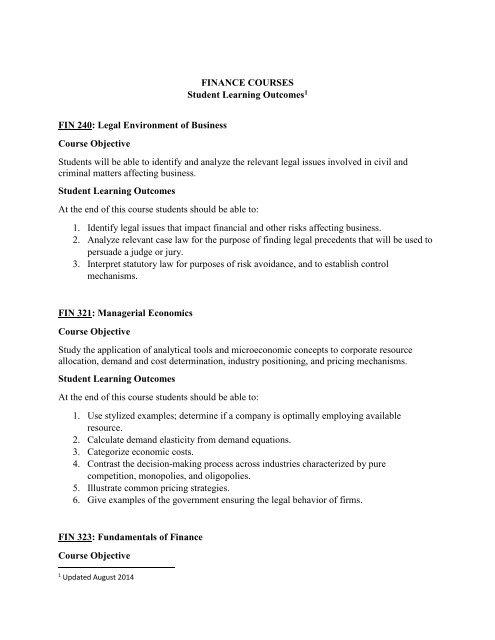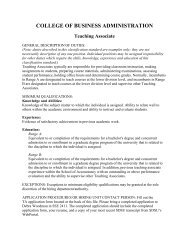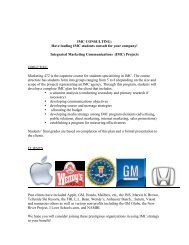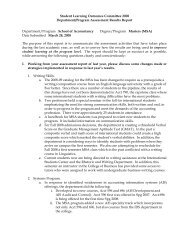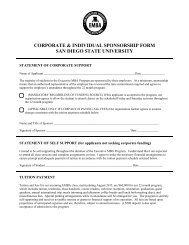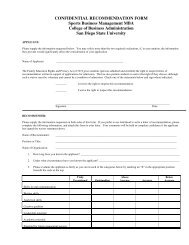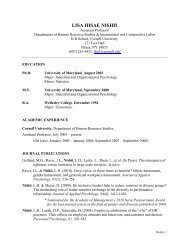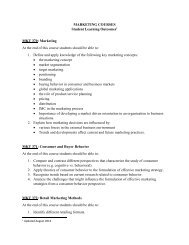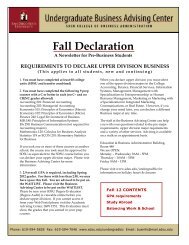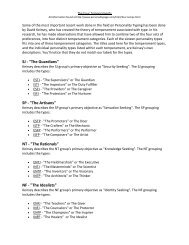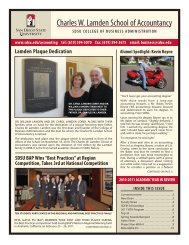FINANCE COURSES – Student Learning Outcomes
FINANCE COURSES – Student Learning Outcomes
FINANCE COURSES – Student Learning Outcomes
You also want an ePaper? Increase the reach of your titles
YUMPU automatically turns print PDFs into web optimized ePapers that Google loves.
<strong>FINANCE</strong> <strong>COURSES</strong><br />
<strong>Student</strong> <strong>Learning</strong> <strong>Outcomes</strong> 1<br />
FIN 240: Legal Environment of Business<br />
Course Objective<br />
<strong>Student</strong>s will be able to identify and analyze the relevant legal issues involved in civil and<br />
criminal matters affecting business.<br />
<strong>Student</strong> <strong>Learning</strong> <strong>Outcomes</strong><br />
At the end of this course students should be able to:<br />
1. Identify legal issues that impact financial and other risks affecting business.<br />
2. Analyze relevant case law for the purpose of finding legal precedents that will be used to<br />
persuade a judge or jury.<br />
3. Interpret statutory law for purposes of risk avoidance, and to establish control<br />
mechanisms.<br />
FIN 321: Managerial Economics<br />
Course Objective<br />
Study the application of analytical tools and microeconomic concepts to corporate resource<br />
allocation, demand and cost determination, industry positioning, and pricing mechanisms.<br />
<strong>Student</strong> <strong>Learning</strong> <strong>Outcomes</strong><br />
At the end of this course students should be able to:<br />
1. Use stylized examples; determine if a company is optimally employing available<br />
resource.<br />
2. Calculate demand elasticity from demand equations.<br />
3. Categorize economic costs.<br />
4. Contrast the decision-making process across industries characterized by pure<br />
competition, monopolies, and oligopolies.<br />
5. Illustrate common pricing strategies.<br />
6. Give examples of the government ensuring the legal behavior of firms.<br />
FIN 323: Fundamentals of Finance<br />
Course Objective<br />
1<br />
Updated August 2014
To obtain an understanding and ability to use basic business financial management concepts and<br />
tools of analysis such as valuation, risk-return relationships, financial statement analysis, capital<br />
budgeting, cost of capital, capital structure, and working capital management. To become<br />
familiar with the various types of financing available to a firm.<br />
<strong>Student</strong> <strong>Learning</strong> <strong>Outcomes</strong><br />
At the end of this course students should be able to:<br />
1. Explain domestic financial markets and institutions and how firms obtain funds in the<br />
financial markets and at what cost.<br />
2. Apply basic valuation concepts.<br />
3. Describe what determines the value of a firm’s securities and how management can<br />
influence these values.<br />
4. Measure a firm’s risk, explain what determines this risk, and how this affects the value of<br />
a firm.<br />
5. Analyze a firm’s performance to determine its strengths and weaknesses, and be able to<br />
use financial analysis to improve performance.<br />
6. Forecast a firm’s financial needs.<br />
7. Discuss the various methods for analyzing projects, how to apply them, and what to do if<br />
there are conflicting recommendations.<br />
8. Manage a firm’s working capital efficiently.<br />
9. Define what leverage is explain how a firm influences its leverage, and how leverage<br />
affects a firm.<br />
10. Describe how firms raise money in foreign markets.<br />
11. Define the finance terminology in the above areas.<br />
FIN 325: Intermediate Finance<br />
Course Objective<br />
To understand theories of value, risk and return, capital investment decisions, financing<br />
decisions, dividend policy, capital structure, and options. Also, to study leasing, corporate<br />
takeovers, and managerial compensation.<br />
<strong>Student</strong> <strong>Learning</strong> <strong>Outcomes</strong><br />
At the end of this course students should be able to:<br />
1. Create and interpret financial statements.<br />
2. Create and interpret cash flow statements.<br />
3. Determine discount/hurdle rates.<br />
4. Evaluate investments in working capital and long-term assets.<br />
5. Demonstrate proficiency in valuation techniques, both DCF (discounted cash flow) and<br />
non-DCF.<br />
6. Apply the contingent claims approach to valuation
FIN 326: Financial Institution Management<br />
Course Objective<br />
To acquire the skills necessary to manage a financial firm, to describe and apply financial<br />
concepts, theories, and tools, and to evaluate the role of technology and the legal, ethical and<br />
economic environment as it relates to financial institutions including the Federal Reserve,<br />
commercial banks, insurance companies, mutual funds, investment banks, pension funds, federal<br />
regulatory agencies, and federal and state guaranty institutions.<br />
<strong>Student</strong> <strong>Learning</strong> <strong>Outcomes</strong><br />
At the end of this course students should be able to:<br />
1. Describe the dimensions of performance and risk relevant to financial firms.<br />
2. Calculate contemporary measures of financial measures of performance and risk.<br />
3. Describe contemporary managerial risk management oversight processes.<br />
4. Explain how the financial services component industries (insurance, banking, securities,<br />
real estate and financial planning) interact.<br />
5. Design hedging strategies to manage market risks (e.g., currency, commodity, economic<br />
and political).<br />
6. Evaluate the economic environment and the impact of governmental economic policies<br />
on consumers and financial institutions.<br />
7. Describe the impact that financial innovation, advances in technology, and changes in<br />
regulations has had on the structure of the financial firms/industry.<br />
FIN 327: Investments<br />
Course Objective<br />
To advance the understanding of fundamental concepts of finance, financial markets and market<br />
participants, valuation techniques of financial instruments, and working knowledge of portfolio<br />
management.<br />
<strong>Student</strong> <strong>Learning</strong> <strong>Outcomes</strong><br />
At the end of this course students should be able to:<br />
1. Describe the general structure of various financial markets.<br />
2. Value financial products such as common stocks (both undervalued and overvalued) and<br />
fixed-income securities.<br />
3. Use financial derivatives as hedging instruments.<br />
4. Build a diversified portfolio and assess portfolio performance.<br />
FIN 328: Entrepreneurial Finance
Course Objective<br />
To study the concepts, techniques, instruments and institutions involved in new venture finance<br />
and private equity, with a special focus on the technology sector, and gain an understanding of<br />
the different stages of investment in an entrepreneurial firm (from early rounds to the exit) and<br />
the structure, strategy, and performance of the venture capital firm.<br />
<strong>Student</strong> <strong>Learning</strong> <strong>Outcomes</strong><br />
At the end of this course students should be able to:<br />
1. Identify the financing process of the entrepreneurial business.<br />
2. Perform financial analysis and plan as applied to startups and forecast free cash flow.<br />
3. Employ corporate finance principles (such as contingent claims and contracting theory)<br />
for the analytical valuation of new ventures.<br />
4. Identify the role of private equity investors<strong>–</strong>for example, angels, VCs, vendors<strong>–</strong>in<br />
startups.<br />
5. Identify the key elements of a good business plan.<br />
6. Analyze the process through which entrepreneurs and private equity investors exit their<br />
investments.<br />
FIN 329: International Business Finance<br />
Course Objective<br />
To study the role that international trade and investment, currency movements, derivative<br />
instruments, hedging strategies, international financial markets, and international agreements and<br />
institutions play in the management of multinational corporations.<br />
<strong>Student</strong> <strong>Learning</strong> <strong>Outcomes</strong><br />
At the end of this course students should be able to:<br />
1. Identify the reasons for international trade.<br />
2. Describe the importance of balance of trade and balance of payments to the development<br />
of macroeconomic policy.<br />
3. Discuss the role that international institutions play in the global arena.<br />
4. Judge whether international parity conditions are met<br />
5. Describe the various currency arrangements a country may adopt<br />
6. Identify opportunities for arbitrage and discuss methods to exploit these opportunities.<br />
7. Describe and distinguish among alternative derivative instruments, including the different<br />
types of exposures multinational corporations face when using derivative instruments.<br />
8. Evaluate cross-border investment opportunities, and describe a multinational firm’s<br />
decision-making process for long-term capital budgeting, short-term cash-flow<br />
management, and the management of international taxation.
FIN 331: Real Estate Principles<br />
Course Objective<br />
To study the fundamentals of real estate, including the concepts, theories and industry practices<br />
in real estate investment, and finance and development decision making, and to gain an<br />
understanding of real estate legal foundations, government regulations, valuation, and brokerage.<br />
<strong>Student</strong> <strong>Learning</strong> <strong>Outcomes</strong><br />
At the end of this course students should be able to:<br />
1. Explain how real estate is defined physically and legally.<br />
2. Explain how different levels of governments, i.e., local government, state government<br />
and the federal government affect the real estate market.<br />
3. Explain how real estate value is determined by market supply and demand, as well as<br />
capital market conditions.<br />
4. Use the market comparison approach to value a residential property and use the income<br />
approach to value an income-producing property.<br />
5. Make mortgage calculations, e.g. monthly payment, amortization table construction and<br />
effective borrowing cost.<br />
6. Explain the common sources of commercial real estate financing.<br />
7. Calculate the NOI, NPV and IRR of a commercial real estate investment and make<br />
investment suggestions.<br />
8. Read a real estate listing contract and a sales contract.<br />
9. Explain the basic process of real estate development.<br />
10. Explain the difference between real estate property management and real estate asset<br />
management.<br />
FIN 333: Law of Real Property<br />
Course Objective<br />
To become familiar with the basic concepts of real property law, including the nature and scope<br />
of real property, estates in land, landlord and tenant relationships, real estate transactions,<br />
mortgages, deeds, easements, land use, ownership rights and responsibilities, and environmental<br />
law, and to gain a broad understanding of the various legal issues associated with real property<br />
and real property transactions.<br />
<strong>Student</strong> <strong>Learning</strong> <strong>Outcomes</strong><br />
At the end of this course students should be able to:<br />
1. Identify and be familiar with the variety of statutory and case law affecting property<br />
owners, tenants, and investors.<br />
2. Assess the legal, monetary, and practical risks/benefits of real estate arrangements and<br />
transactions.
3. Make thoughtful, well-reasoned property decisions that result in maximum satisfaction<br />
and profitability, and minimal risk.<br />
FIN 421: Portfolio Management and Security Analysis<br />
Course Objective<br />
To understand the empirical and theoretical implications of the financial environment and<br />
valuation techniques on optimal portfolio management.<br />
<strong>Student</strong> <strong>Learning</strong> <strong>Outcomes</strong><br />
At the end of this course students should be able to:<br />
1. Analyze and evaluate financial markets, how securities are traded, mutual funds,<br />
investment companies, and investor behavior.<br />
2. Construct optimal portfolios and illustrate the theory and empirical applications of assetpricing<br />
models.<br />
3. Explain macro and industry analysis, equity valuation, financial statement analysis and<br />
technical analysis.<br />
4. Analyze bond prices and yields and fixed-income portfolios.<br />
5. Explain what options and futures are and their use as hedging instruments.<br />
6. Characterize the implications of the market efficiency evidence on active portfolio<br />
management.<br />
FIN 423: Financial Analysis and Management<br />
Course Objective<br />
To develop critical thinking and problem solving competencies, at both the individual and group<br />
levels, of financial statement analysis, financial planning, principles of valuation, capital<br />
budgeting, capital structure, and issues in financial policy, and to apply financial theory to<br />
analyze real life situations in an uncertain environment with an incomplete data set.<br />
<strong>Student</strong> <strong>Learning</strong> <strong>Outcomes</strong><br />
At the end of this course students should be able to:<br />
1. Use Financial Statements to evaluate firm performance.<br />
2. Project Financial Statements (B/S, I/S, budgets, etc.).<br />
3. Use Financial Statements to obtain Cash Flows for the firm and equity holders.<br />
4. Calculate and project Free Cash Flow.<br />
5. Determine financial drivers of Free Cash Flow.<br />
6. Calculate the cost of debt, cost of equity and the Cost of Capital.<br />
7. Use DCF and other valuation techniques to value projects and firms; perform risk<br />
analysis; analyze Mergers, Acquisitions, Leverage Buyouts and Initial public Offerings.
8. Evaluate alternative financing options.<br />
9. Evaluate the economic and industry environment, domestic and international.<br />
10. Develop hands-on, pro forma modeling skills using Excel.<br />
11. Develop presentation and writing skills.<br />
FIN 427: Derivatives and Financial Risk Management<br />
Course Objective<br />
To understand issues pertaining to pricing and hedging with options on individual stocks and<br />
indexes, to examine forwards and futures contracts for equity indexes, commodities, and<br />
currencies, and to analyze second generation derivative products such as interest rates and the<br />
management of credit risks.<br />
<strong>Student</strong> <strong>Learning</strong> <strong>Outcomes</strong><br />
At the end of this course students should be able to:<br />
1. To have a discussion and explain in detail financial instruments such as options, futures,<br />
swaps and other derivative securities.<br />
2. Describe and understand the economic environment in which such instruments operate.<br />
3. Develop and employ theoretical valuation methods to price these financial instruments.<br />
4. Apply these instruments in managing the risk of investing and hedging activity at the<br />
individual and the corporate level.<br />
FIN 431: Real Estate Finance<br />
Course Objective<br />
To acquire the knowledge and develop the analytical skills for jobs in the real estate<br />
development, brokerage, mortgage banking and investment banking industries.<br />
<strong>Student</strong> <strong>Learning</strong> <strong>Outcomes</strong><br />
At the end of this course students should be able to:<br />
1. Identify different types of mortgages available in the market and explain their<br />
characteristics.<br />
2. Calculate fixed-rate mortgages (FRM) and adjustable-rate mortgages (ARM) (e.g.<br />
monthly payment, amortization and effective borrowing cost) and make a rational choice<br />
among various mortgages based on the calculations.<br />
3. Identify the major players in the US secondary mortgage market and explain how the<br />
market is functioning.<br />
4. Analyze the impacts of the recent mortgage market crisis on financial markets and on the<br />
US economy.
5. Compare different sources of commercial real estate financing (both the debt side and the<br />
equity side) and analyze how leverage affects risk and return.<br />
6. Explain what Mortgage-backed Bonds (MBBs), Mortgage-backed Securities (MBS) and<br />
Commercial Mortgage-backed Securities are.<br />
FIN 433: Theory of Real Property Value<br />
Course Objective<br />
To provide a foundation for the valuation of real estate and a comprehensive review of the<br />
concepts and tools used for placing an economic value on real property for purposes of<br />
acquisition, divestiture or investment.<br />
<strong>Student</strong> <strong>Learning</strong> <strong>Outcomes</strong><br />
At the end of this course students should be able to:<br />
1. Describe and explain basic concepts of real estate valuation.<br />
2. Estimate the value of property using the sales comparison approach.<br />
3. Estimate the value of property using the income approach.<br />
4. Estimate the value of property using the cost approach.<br />
5. Interact with appraisers and interpret appraisal reports upon entering the real estate<br />
industry.<br />
FIN 435: Real Estate Investment Analysis<br />
Course Objective<br />
To gain an understanding of how debt and equity funds are attracted to capitalize investment real<br />
estate by utilizing standard investment measures of Internal Rate of Return, Net Present Value<br />
and Return on Investment to evaluate prospective real estate investments and formulate<br />
investment strategies that will optimize the investor’s expected investment outcome.<br />
<strong>Student</strong> <strong>Learning</strong> <strong>Outcomes</strong><br />
At the end of this course students should be able to:<br />
1. Create and evaluate real estate investment cash flow models and pro formas.<br />
2. Determine a defensible methodology to forecast real estate investment cash flows and<br />
measure investment performance.<br />
3. Use discounted cash flow models to measure the impact of alternative investment<br />
strategies in order to formulate a strategy to maximize investment yield. Variables for<br />
comparison will include alternative financing, project density, income and expense<br />
expectations.<br />
4. Identify real estate investment risk factors and measure their impact on investment<br />
performance in order to identify the optimum real estate investment strategy.
5. Complete an investment real estate loan request package that is intended to attract debt<br />
financing to a real estate investment that they select.<br />
6. Formulate a real estate investment strategy for one or more properties.<br />
7. Work effectively in a group.<br />
8. Display effective oral communication skills.<br />
FIN 437: Real Estate Development<br />
Course Objective<br />
To obtain a sufficient understanding of the development process, enabling students to gain an<br />
entry-level position in the real estate industry.<br />
<strong>Student</strong> <strong>Learning</strong> <strong>Outcomes</strong><br />
At the end of this course students should be able to:<br />
1. Describe past real estate downturns, their causes, their lessons, and why oversupply<br />
seems to recur despite those lessons.<br />
2. Describe the phases of real estate development, the roles of people involved in each, the<br />
tools they have at their disposal, the challenges and risks associated with each phase, and<br />
the opportunities to add value each step of the way.<br />
3. Perform feasibility analysis, both at the market and project level.<br />
4. Analyze real estate market data and others’ interpretations of that data.<br />
5. Plan a development.<br />
6. Confront the issues facing developers in the 21 st century.<br />
FIN 438: Mortgage Banking<br />
Course Objective<br />
Develop an understanding of real estate finance from the viewpoint of the lender<strong>–</strong>how loans are<br />
sourced, underwritten, financed and serviced. Develop an understanding of the causes and<br />
consequences of the U.S. mortgage and real estate crisis.<br />
<strong>Student</strong> <strong>Learning</strong> <strong>Outcomes</strong><br />
At the end of this course students should be able to:<br />
1. Describe core functions of mortgage banking: origination, underwriting, servicing, loss<br />
mitigation for both commercial and residential.<br />
2. Explain the principal mortgage instruments used to finance residential and commercial<br />
real estate; characteristics, pricing, performance.<br />
3. Describe the institutions and instruments involved in funding real estate<strong>–</strong>debt and equity<br />
for both commercial and residential.<br />
4. Explain the causes and consequences of the US mortgage crisis of 2007-2011.
5. Describe and explain mortgage securitization; security types, performance.<br />
6. Explain the economics of the mortgage banking business.<br />
7. Explain the major risks in mortgage lending and mitigation.<br />
8. Identify, describe, and explain the major forms of consumer protection for mortgage<br />
borrowers, their inadequacies and opportunities for reform.<br />
FIN 522: Individual Insurance Management<br />
Course Objective<br />
To study risk management and insurance decisions in personal financial planning, with<br />
applications to insurance for life, health, disability, property and liability risks, as well as<br />
annuities, group insurance, and long term care.<br />
<strong>Student</strong> <strong>Learning</strong> <strong>Outcomes</strong><br />
At the end of this course students should be able to:<br />
1. Explain key insurance terminology and contract features.<br />
2. Evaluate client insurance and risk management needs.<br />
3. Identify and explain features of private and public insurance available to meet each<br />
identified need.<br />
4. Demonstrate the ability to appropriately select from available products to meet clients’<br />
needs.<br />
5. Integrate the tax implications into insurance decisions.<br />
6. Incorporate employee benefits into financial planning recommendations.<br />
7. Develop the analytic al skills necessary to make optimal decisions relatively to insurance<br />
products and alternative strategies.<br />
8. Process information effectively from realistic insurance documents.<br />
9. Use spreadsheets to project products illustrations.<br />
FIN 585: Estate Planning Issues and Practice<br />
Course Objective<br />
The student will become accomplished in estate planning principles and practices so that the<br />
student will be prepared to counsel clients on the estate planning component of establishing a<br />
financial plan.<br />
<strong>Student</strong> <strong>Learning</strong> <strong>Outcomes</strong><br />
At the end of this course students should be able to:<br />
1. Interpret and apply Estate and Gift Tax statutes and regulations<strong>–</strong>and income taxes as they<br />
pertain to estates and trusts.
2. Describe primary estate planning documents, such as wills, trust s, durable powers of<br />
attorney, annuities and insurance policies.<br />
3. Explain the process of probate and probate avoidance devices.<br />
4. Describe bypass and marital deduction trusts<br />
5. Describe strategies for lifetime transfers of assets<br />
6. Explain tax and non-tax issues affecting closely held businesses.<br />
FIN 589: Personal Financial Planning<br />
Course Objective<br />
To study the financial planning process including establishing the relationship, gathering data,<br />
evaluating financial statement, cash flow and debt considerations, goal programming (including<br />
investment, education and retirement funding) and integration of plan elements.<br />
<strong>Student</strong> <strong>Learning</strong> <strong>Outcomes</strong><br />
At the end of this course students should be able to:<br />
1. Explain and define the nature of the financial services industry with respect to providing<br />
personal financial planning services and compare those services with those provided by<br />
professional planners.<br />
2. Describe and execute the steps involved in developing a financial plan<br />
3. Evaluate the trends that make financial planning an emerging profession.<br />
4. Evaluate a client’s psychological attitudes so that a plan can be implemented that is<br />
acceptable to the clients.<br />
5. Use communications skills necessary to gather needed client information and to motivate<br />
clients to execute advice.<br />
6. Create meaningful family financial statements and interpret them so as to recognize<br />
problems and opportunities, strengths and weaknesses.<br />
7. Evaluate client’s emergency funds, preparation for fiscal stress and credit worthiness and<br />
their use of debt and propose improvements.<br />
8. Analyze and evaluate various investment alternatives and strategies and match them with<br />
specific client needs and objectives.<br />
9. Evaluate a client’s ability to reach their financial objectives and strategies for meeting<br />
them. These include investment, education and retirement planning.<br />
FIN 590: Personal Financial Planning Practicum<br />
<strong>Student</strong> <strong>Learning</strong> <strong>Outcomes</strong><br />
At the end of this course students should be able to:<br />
1. Apply and integrate the content found within the Financial Planning curriculum in the<br />
formulation of a financial plan.
2. Effectively communicate the financial plan, both orally and in writing, including<br />
information based on research, peer, colleague or simulated client interaction and/or<br />
results emanating from synthesis of material.<br />
3. Collect all necessary and relevant qualitative and quantitative information required to<br />
develop a financial plan.<br />
4. Analyze personal financial situations; evaluate clients’ objectives, needs, and values to<br />
develop an appropriate strategy within the financial plan.<br />
5. Demonstrate logic and reasoning to identify the strengths and weaknesses of various<br />
approaches to a specific problem.<br />
6. Evaluate the impact of economic, political, and regulatory issues with regard to the<br />
financial plan.<br />
7. Apply the CFP Board Financial Planning Practice Standards to the financial planning<br />
process.<br />
8. Evaluate various complex ethical issues planners face using the CFP Code of Ethics as a<br />
standard.<br />
9. Apply communications, counseling and behavioral finance theory to complex client<br />
interactions.<br />
FIN 604: Legal Environment for Executives<br />
Course Objective<br />
To learn the rules governing our exchanging with one another and to effectively analyze an<br />
exchange by properly applying the law.<br />
<strong>Student</strong> <strong>Learning</strong> <strong>Outcomes</strong><br />
At the end of this course students should be able to:<br />
1. Identify and interpret sources of law affecting business.<br />
2. Analyze legal issues affecting business.<br />
FIN 617: Financial Management II<br />
Course Objective<br />
To provide, in conjunction with BA 629, a complete overview of modern corporate finance,<br />
including relevant theory and practical application.<br />
<strong>Student</strong> <strong>Learning</strong> <strong>Outcomes</strong><br />
At the end of this course students should be able to:<br />
1. Calculate common investment criteria and project cash flows associated with corporate<br />
project evaluation.
2. Apply measures of cost of capital and financial leverage to form long-term financial<br />
policies for business.<br />
3. Judge the merits of leasing over borrowing to purchase assets.<br />
4. Describe the common factors influencing dividend policy.<br />
5. Describe applications of options in financial management.<br />
6. Relate capital investment decisions and financial policies to business valuations.<br />
FIN 641: Financing the Emerging Enterprise<br />
Course Objective<br />
To study the role of finance in a Value Based Entrepreneurial Management Framework through<br />
identification of Market Opportunity, Competitive Position, and the Composition and Terms of<br />
Financing, and to gain understanding of how these elements interact to create value for the<br />
founders and investors in a venture.<br />
<strong>Student</strong> <strong>Learning</strong> <strong>Outcomes</strong><br />
At the end of this course students should be able to:<br />
1. Identify and explain the key elements<strong>–</strong>Opportunity, Competitive Position, and the<br />
Composition and Terms of Financing, i.e., Deal Structure<strong>–</strong>of the Value Based<br />
Entrepreneurial Management Framework.<br />
2. Explain cash flow and working capital management, and financial analysis and planning<br />
as applied to startups.<br />
3. Discuss valuation analysis and valuation issues as applied to startups.<br />
4. Explain the role of investors<strong>–</strong>for example, angels VCs, vendors<strong>–</strong>in startups.<br />
FIN 642: Financial Risk Management<br />
(Course not currently being offered)<br />
Course Objective<br />
To understand issues pertaining to pricing and hedging with options on individual stocks and<br />
indexes, to examine forwards and futures contracts for equity indexes, commodities, and<br />
currencies, and to analyze second generation derivative products such as interest rates and the<br />
management of credit risks. Current topics will be covered as relevant.<br />
<strong>Student</strong> <strong>Learning</strong> <strong>Outcomes</strong><br />
At the end of this course students should be able to:<br />
1. Provide a detailed explanation of financial instruments such as options, futures, swaps<br />
and other derivative securities.<br />
2. Describe the economic environment in which such instruments operate.<br />
3. Develop and employ theoretical valuation methods to price these financial instruments.
4. Apply these instruments in managing the risk of investing and hedging activity at the<br />
individual and the corporate level.<br />
FIN 651: Seminar in Investments<br />
Course Objective<br />
To study the advance the structure and functioning of financial markets as well as the role and<br />
performance of the various market participants, to understand the theory and the empirical<br />
evidence on modern portfolio theory and asset pricing models, and assess the overall<br />
implications for active management and market efficiency.<br />
<strong>Student</strong> <strong>Learning</strong> <strong>Outcomes</strong><br />
At the end of this course students should be able to:<br />
1. Evaluate the structure of financial markets, the different types of securities, and the<br />
performance of market participants.<br />
2. Construct optimal portfolios following the tenets of modern portfolio theory.<br />
3. Illustrate the theory and empirical applications of asset-pricing models: the CAPM, APT<br />
and multifactor asset pricing models.<br />
4. Appraise the empirical evidence on securities returns, active management and the related<br />
implications for market efficiency.<br />
FIN 652: Seminar in Security Analysis and Portfolio Management<br />
Course Objective<br />
To examine the determinants and behavior of asset prices, to provide financial theory and the<br />
analytical tools needed to make good investment decisions, and to model the relationship<br />
between risk and return, optimal portfolio selection, asset pricing models, market efficiency,<br />
portfolio performance evaluation, and the theory of active portfolio management.<br />
<strong>Student</strong> <strong>Learning</strong> <strong>Outcomes</strong><br />
At the end of this course students should be able to:<br />
1. Describe the steps of the portfolio management process.<br />
2. Make investment policy recommendations, including the determination of an optimal<br />
asset allocation.<br />
3. Analyze and evaluate the performance of an investment manager.<br />
4. Analyze bond portfolio management strategies.<br />
5. Explain the concept of market efficiency.<br />
6. Explain how asset prices should be determined according to some of the main financial<br />
theories.<br />
7. Explain how derivatives products can be used in portfolio management.
FIN 653: Case Studies in Financial Management<br />
Course Objective<br />
To bring financial management decisions from the business world to the classroom, through the<br />
case method approach, by helping students develop decision-making skills in unstructured,<br />
uncertain, and complex (i.e., realistic) situations. The assigned cases cover a broad range of<br />
financial analysis with an emphasis on strategic valuations (mergers, acquisitions, and<br />
restructurings) and corporate financial strategy.<br />
<strong>Student</strong> <strong>Learning</strong> <strong>Outcomes</strong><br />
At the end of this course students should be able to:<br />
1. Calculate capital budgeting and resource allocation.<br />
2. Describe and explain the management of corporate capital structure.<br />
3. Evaluate corporate projects using scenario, sensitivity, and simulation analysis.<br />
4. Analyze corporate acquisitions, and value enterprise, form of payment, and form of<br />
financing.<br />
5. Apply option pricing theory to project valuation.<br />
FIN 654: Seminar in International Business Finance<br />
Course Objective<br />
To develop an understanding of: international financial instruments, markets, and institutions;<br />
international trade and capital flows; foreign exchange risks and their management; direct and<br />
portfolio investment; implications for the conduct of global business.<br />
<strong>Student</strong> <strong>Learning</strong> <strong>Outcomes</strong><br />
At the end of this course students should be able to:<br />
1. Identify the key aspects of international trade and calculate its potential gains to<br />
participating nations.<br />
2. Describe the characteristics of foreign exchange markets, identify the different currency<br />
regimes, and measure the gains/losses from engaging in speculative and arbitrage<br />
activities.<br />
3. Judge whether international parity conditions are met and predict the impact of<br />
imbalances on foreign exchange markets.<br />
4. Calculate common measures of foreign exchange risk.<br />
5. Illustrate the use of currency derivatives to achieve a desired level of foreign exchange<br />
risk exposure.<br />
6. Identify the major elements of long-and short-term international capital movements.
7. Evaluate cross-border investment opportunities, and describe a multinational firm’s<br />
decision-making process for long-term capital budgeting, short-term cash-flow<br />
management, and the management of international taxation.<br />
FIN 656: Seminar in Financial Institutions<br />
Course Objective<br />
To develop an understanding of the management of financial institutions, including the<br />
techniques used by managers of financial institutions to measure and manage risks. A secondary<br />
objective is to appraise the impact of the evolving regulatory and technological environment on<br />
the management of financial institutions.<br />
<strong>Student</strong> <strong>Learning</strong> <strong>Outcomes</strong><br />
At the end of this course students should be able to:<br />
1. Calculate appropriate measures of key risks facing financial institutions.<br />
2. Describe and appraise alternative techniques to manage prevalent risks facing financial<br />
institutions.<br />
3. Create simple models to estimate value-at-risk.<br />
4. In the context of a bank management simulation, develop and implement lending,<br />
investments, deposits, capital, and risk management strategies to create value.<br />
5. Discuss the impact of evolving regulatory and technological environments on the<br />
management of financial institutions.<br />
FIN 657: Financial and Retirement Planning<br />
Course Objective<br />
To study the integrative aspects of the MSBA concentration in Financial and Tax Planning<br />
through practical applications based on cases, actual financial counseling and financial plan<br />
writing and critique.<br />
<strong>Student</strong> <strong>Learning</strong> <strong>Outcomes</strong><br />
At the end of this course students should be able to:<br />
1. Design a system of gathering needed information from clients.<br />
2. Select relevant information for analysis.<br />
3. Analyze, assess and interpret the selected data provided in cases and from clients.<br />
4. Integrate the fields of investments, taxation, insurance, estate and benefits planning.<br />
5. Prioritize client goals with an eye to optimizing client resources.<br />
6. Judge which of alternative strategies best fulfill client needs.<br />
7. Conclude with recommendations that serve as recommendations to clients.
8. Design and prepare a financial plan, including recommendations in format that is<br />
understandable to clients.<br />
9. Present findings to clients and other observers.<br />
10. Critically analyze the findings of others.<br />
11. Prepare a seminar on a financial planning topic of interest for an uneducated audience.<br />
12. Evaluate the usefulness of commercial financial planning software.<br />
FIN 659: Decision Making in the World Economy<br />
Course Objective<br />
To develop an understanding of the world economy and to illustrate the impact of the economic<br />
environment on the decision making process of business managers.<br />
<strong>Student</strong> <strong>Learning</strong> <strong>Outcomes</strong><br />
At the end of this course students should be able to:<br />
1. Employ government macroeconomic statistics to assess the current business climate.<br />
2. Judge whether a firm’s operating strategies and financial policies are consistent with<br />
economic conditions.<br />
3. Forecast the impact of government economic policies, especially monetary policy, on a<br />
business.<br />
4. Conduct country analysis to evaluate foreign direct and portfolio investment<br />
opportunities in a country.<br />
5. Forecast the impact of economic shocks and government policy decisions on interest<br />
rates, output, prices, and exchange rates using standard macroeconomic models.<br />
FIN 705: Seminar in Estate Planning<br />
(Course not currently being offered)<br />
FIN 783: Seminar in Real Estate Investment and Development<br />
Course Objective<br />
To gain practical knowledge about personal and commercial real estate investment and<br />
development.<br />
<strong>Student</strong> <strong>Learning</strong> <strong>Outcomes</strong><br />
At the end of this course students should be able to:<br />
1. Describe and explain the theory and practice of real estate investment and development.<br />
2. Explain real estate market research and analysis, and taxation.
3. Use spreadsheets, writing and presenting real estate business reports.<br />
4. Apply critical real estate analysis.<br />
FIN 784: Seminar in Real Estate Finance and Valuation<br />
Course Objective<br />
To study the valuing and some financing aspects of real estate, including the methods and<br />
techniques used in the valuation of real property rights, along with the attributes, amenities, and<br />
social policies affecting the value of those rights which include theories on the valuation of real<br />
property, methodological issues in valuation models, empirical/economic-effect studies, and<br />
financing analysis for real estate market participants.<br />
<strong>Student</strong> <strong>Learning</strong> <strong>Outcomes</strong><br />
At the end of this course students should be able to:<br />
1. Identify and explain the basic concepts of real estate valuation.<br />
2. Estimate the value of property using the sales comparison approach, the income<br />
approach, and the cost approach.<br />
3. Interact with appraisers and interpret appraisal reports upon entering the industry.<br />
4. Identify and explain valuation methods and techniques.<br />
5. Research the literature on a valuation topic.<br />
BA 626: Managerial Economics<br />
Course Objective<br />
To enhance proficiency in the application of microeconomic concepts and analytical tools to<br />
managerial pricing and resource allocation decision making.<br />
<strong>Student</strong> <strong>Learning</strong> <strong>Outcomes</strong><br />
At the end of this course students should be able to:<br />
1. Identify, gather, and analyze evidence about demand conditions and price elasticities to<br />
develop pricing policies and strategies.<br />
2. Judge whether a firm is employing the optimal mix of inputs.<br />
3. Identify and analyze a firm’s economic costs.<br />
4. Determine the existence of economies of scale and scope and assess their impact on a<br />
firm’s competitive position.<br />
5. Evaluate pricing and other competitive strategies in the context of the structure of a<br />
firm’s market.<br />
6. Identify and give examples of how uncertainty may impact consumer and firm behavior
BA 629: Financial Management I<br />
Course Objective<br />
To obtain an understanding and ability to use basic business financial management concepts and<br />
tools of analysis such as valuation, risk-return relationships, financial statement analysis, capital<br />
budgeting, cost of capital, capital structure and working capital management, and to become<br />
familiar with the various types of financing available to a firm.<br />
<strong>Student</strong> <strong>Learning</strong> <strong>Outcomes</strong><br />
At the end of this course students should be able to:<br />
1. Analyze financial statements using standard financial ratios of liquidity, activity, debt,<br />
profitability, and market value.<br />
2. Apply techniques to project financial statements for forecasting long-term financial<br />
needs.<br />
3. Explain the role of short-term financial management, and the key strategies and<br />
techniques used to manage cash, marketable securities, accounts receivable and<br />
inventory.<br />
4. Identify the major sources of short-term financing available to the firm.<br />
5. Apply future value and present value concepts to single sums, mixed streams, and<br />
annuities.<br />
6. Apply time value, risk, and return concepts. Apply valuation techniques to bonds.<br />
7. Apply time value, risk, and return concepts to constant and variable growth models.<br />
Apply valuation techniques to stocks.<br />
8. Identify relevant cash flows for capital budgeting projects and apply various methods to<br />
analyze projects.<br />
9. Apply the concept of risk, its measurement for single assets and portfolios, various types<br />
of risk, the source and use of betas, and the CAPM and SML.<br />
10. Apply techniques for estimating the cost of each component of the cost of capital and<br />
understand how to assemble this information into a cost of capital.<br />
11. Explain the concept of leverage and the benefits and costs associated with debt financing.<br />
12. Identify the various long-term sources of funds for a firm.<br />
13. Identify and explain the key international differences between major domestic financial<br />
management tools, techniques, and practices and those environmental and<br />
methodological differences that occur in the global market.


